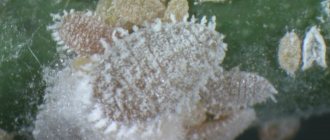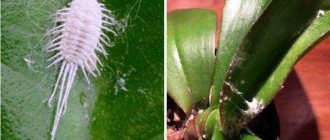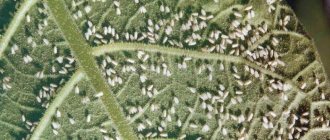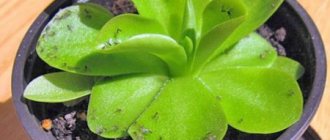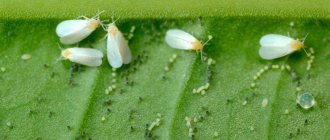Author: Elena N. https://floristics.info/ru/index.php?option=com_contact&view=contact&id=19 Category: Plant Pests Published: November 07, 2017Last edits: October 26, 2020
- Mealybug on grapes
Mealybugs (lat. Pseudococcidae), or pseudocushions, or felt insects, represent a family of hemipteran insects, including more than 2,200 species. Only 330 of them are found in Europe. The mealybug is a widespread insect that damages food, greenhouse and indoor plants, including cacti and succulents. People call these pests “hairy lice.”
Mealybug pest - description
The mealybug has a characteristic appearance and is large in size compared to other insects, but an inexperienced gardener may not immediately detect the onset of the invasion, which greatly complicates the fight against the pest.
The length of the mealybug can reach from 3 to 10 mm. Females and males differ significantly in appearance. The female pest has an oval body covered with white powdery wax, she has many short legs and long thread-like antennae. The scale insect larva is similar to the female, but smaller in size. And males are winged insects that resemble flies or mosquitoes. They do not have mouthparts, do not feed on plants and do not harm them.
What are the harms of mealybugs? These are sucking pests that feed on cell sap, which first leads to a slowdown and then to a complete cessation of plant growth and development. During their life, mealybugs secrete honeydew, or honeydew - a sweet and sticky liquid, which is a favorable environment for the development of various fungal diseases, in particular sooty fungus. The mealybug pest damages all organs - both ground and roots, and easily moves to neighboring plants.
- Flat mite / Brevipalpus
Of the many species, the most famous are the greenhouse plate, bamboo, citrus, seaside, grape, Australian grooved, root, bristle and Comstock bugs.
What harm does
Gluttonous females and larvae cause enormous damage to plants: they stick to young stems and leaves and completely draw out the juices from them. This inhibits the plant, slows down its development, and reduces productivity.
Signs and causes of infection
White coating on leaves and shoots is the main symptom of mealybug infestation.
You can suspect the appearance of mealybugs on plants in the garden by the characteristic white spots that resemble lumps of cotton wool. If you look closely, you will notice that the lumps are moving and moving along the stems and leaves.
You will then notice that the leaves and stems are covered with balls of waxy threads. This is a protective shell for laying eggs that females lay on the plant. The surface of the leaves is covered with a sticky coating, honeydew, which is secreted by pests.
Female mealybugs are extremely fertile. During the season they make from 2 to 4 clutches. The first instar larvae are called wanderers because they actively move through parts of the plant. Then they stick to the tissues and lose mobility. Larvae of subsequent instars after molting are forced to look for a new habitat, so they begin to move to neighboring plants.
In areas where the pest has lived for a long time, black spots appear - sooty fungi that have multiplied on insect secretions.
The scale insect does not suddenly appear on plantings. Favorable conditions are required for its reproduction:
- Excessively dry air and soil due to violation of watering and spraying standards;
- Weakened plant immunity due to violation of agricultural practices;
- Excess nitrogen content in the soil, which creates favorable conditions for the life of insects.
Mealybugs live in symbiosis with ants, which feed on the sweet secretions of insects and therefore protect them from predators and even carry eggs for active dispersal throughout the area. If a white coating is detected on plants, it is worth assessing the number of ants in the area and also actively combating them.
Mealybug - preventive treatment
To prevent plants from being damaged by the pest, it is necessary to carry out the following preventive measures:
- regularly inspect the plants, especially the underside, leaf axils and buds ;
- promptly remove dried leaves, shoots, branches and buds that attract pests;
- observe the watering regime: moisture should be regular and sufficient;
- from time to time give indoor flowers a warm shower;
- place each new plant in quarantine , that is, keep it for at least a couple of weeks away from other indoor flowers and be sure to treat it with an insecticide for preventive purposes.
Mealybugs thrive at temperatures above 25 ºC and high air humidity, so in such conditions preventive inspection of plants should become frequent and mandatory.
Causes of the pest
Infection of indoor plants with mealybugs occurs in several ways, for example:
- the pest came from another diseased flower;
- carried by the wind if the flower pot was standing on an open balcony or on a glassed-in veranda;
- contaminated soil was used, which was brought from the garden or bought from an unknown flower seller.
As a rule, mealybugs appear on a plant that is weakened as a result of improper care. These may be mistakes that novice gardeners make:
- Excessive waterlogging of the soil or lack of watering.
- The temperature regime, ambient humidity or lighting in the room are disturbed.
- Lack or absence of water treatments for the plant.
- Poor hygiene inspection, which must be carried out regularly.
- Untimely removal of dry leaves or shoots, dead buds.
Important! After purchasing a new flower, you must comply with the quarantine period for it. Place in a separate room for two weeks, away from other indoor plants.
How to deal with mealybugs at home
Remedies for mealybugs (preparations)
How to treat plants against mealybugs? Almost all insecticides cope with this pest, but the best of them are considered to be:
- Admiral is a hormonal insecticide with enteric contact action (active ingredient is pyriproxyfen);
- Aktara for mealybug - an insecticide with enteric contact action (active ingredient - thiamethoxam);
- Actellik is a non-systemic organophosphate insectoacaricide with enteric contact action (active ingredient – pirimiphos-methyl). Due to its high toxicity, the drug is not recommended for use indoors;
- Apploud – insecticide (active ingredient – buprofezin);
- Bankol is an insecticide with enteric contact action (active ingredient – bensultap);
- Biotlin is a systemic insecticide with enteric contact action (active ingredient – imidacloprid);
- Bitoxibacillin is a biological preparation with insectoacaricidal properties to protect plants from pests;
- Inta-vir is a broad-spectrum insecticide with enteric contact action (active ingredient – cypermethrin);
- Commander is a systemic insecticide with enteric contact action (active ingredient – imidacloprid);
- Confidant is a systemic insecticide with enteric contact action (active ingredient – imidacloprid);
- Mospilan is a systemic insecticide with enteric contact action (active ingredient – acetamiprid);
- Tanrek is a broad-spectrum systemic insecticide with enteric contact action (active ingredient – imidacloprid);
- Fitoverm is an insectoacaricide of biological origin with enteric contact action (active ingredient - aversectin).
In addition to those described, there are other effective drugs against mealybugs , for example, Dantop (Ponche, Apache), Vertimek, Spark Double Effect and Calypso.
Mealybug on orchids
Mealybugs settle on ficus, dracaena and even cacti, but most often mealybugs appear on flowers - on orchids and violets, for example. When examining your indoor plants, the following symptoms will help you determine that this particular pest has settled on them:
- Colorado potato beetle: how to get rid of the pest
- the plant seems to be sprinkled with a loose powdery coating;
- the flower droops, its leaves lose turgor;
- Sticky spots of honeydew form on the external organs of the plant;
- the plant is covered with oval white insects.
If you find at least one of the listed signs, immediately begin saving the flower. How to deal with mealybugs on an orchid? First of all, it needs to be isolated so that the pests do not spread to other flowers. Dilute 2 g of green soap in 100 ml of water and very carefully wipe the ground organs of the orchid with this solution using a sponge or cotton pad. You need to penetrate into the cracks between the trunk and leaves with a brush soaked in the solution, since pests like to settle in hard-to-reach places. Don't forget to wash the leaves from the underside. After this, you need to spray the flower three times with an interval of 7-10 days with some folk remedy (infusions of tobacco or garlic, cyclamen decoction). Only treating the orchid three times will give the desired result, although it will seem to you that the pests have disappeared after the first spraying.
Among the chemical preparations against mealybugs on orchids, Fitoverm, Inta-vir and Bitoxibacillin are the most effective.
Mealybug on violets
For violets, the mealybug is the most difficult and insidious pest. It is difficult to track the moment when the scale insect appears on violets, since almost its entire cycle takes place underground. But even when the enemy is discovered, it turns out that fighting him is not so easy: he is ideally protected by the structural features of his body.
In the fight against mealybugs on violets, do not waste time trying to cope with the pest with folk remedies, but immediately use systemic insecticides. It is best to treat violets with Actellik: 2-3 sprayings at weekly intervals with a solution of 2 ml of the drug in 1 liter of water will destroy insects of all stages of development, except eggs. However, plant treatment should be carried out outdoors. If after this, scale insects appear on the violets, you will have to remove each plant from the pot, clean the roots from the soil, carefully treat the stem, axils of the lower leaves and the roots of the violet with a systemic insecticide, and then plant the plant in a fresh substrate.
Mealybug on cacti
If your cactus suddenly began to grow slowly, but you did not find any pests on it, this does not mean that there are none: you must definitely inspect the root system of the plant. Usually, scale insects suck the juice from the fresh growth of the tops of cacti and other succulents, but at the same time they can be found on the roots at the base of the stem and in the earthen coma. Signs of the harmful activity of mealybugs on a cactus may include deformation of young leaves and growth points, as well as brown or reddened marks - bite sites.
To kill mealybugs on cacti, you will need 3 treatments of the above-ground parts of the plants with a systemic insecticide at intervals of 10-15 days. During each spraying, it is necessary to spill the insecticide solution on the soil in which the cacti grow.
Hot water has a very effective effect on the pest: the plants are removed from the pots and washed under running water at a temperature of 45-50 ºC, mechanically removing pests from them and washing the roots from the ground. After washing, the cacti are completely immersed in a solution of a systemic insecticide for several hours, then dried and planted in a fresh, disinfected substrate. Of the chemicals used to combat scale insects on cacti, Decis, Apollo, Karbofos, Fufanon, Actellik, Sherpa and preparations based on imidacloprid have proven themselves well.
- Potatoes: treatment before planting
If there are few pests, it may be enough to treat the plant with garlic tincture. It is more convenient to do this with a cotton swab.
Mealybug on dracaena
Signs of damage to dracaena mealybugs are white bloom and spots of honeydew on the stems and leaves of the plant, loss of turgor in the leaves, the formation of brown spots on them and curvature of the stem. Mealybugs appear on the plant in conditions of too high humidity at temperatures above 25 ºC.
Mealybugs on dracaena need to be combated comprehensively, that is, in addition to treating the plant by leaves, it is necessary to disinfect the soil in which the dracaena grows. Among the chemical preparations in the fight against scale insects, Fitoverm has proven itself well, which should be used to treat the plant 4 times with an interval of 1 week. Confidor also copes well with the pest, but the most effective remedy is still Aktara: to spray dracaena on the leaves, use a solution of 4 g of the drug in 5 liters of water, and to treat the soil in a pot, you need to dilute 0.7 g of Aktara in 1 liter of water. However, whatever preparation you prefer, first try to wash off the insects from the plant or remove them using a cotton swab dipped in a soapy solution.
Tick and flea repellent
Flea and tick repellents with the active ingredient imidacloprid (finpronil, cypermethrin) effectively help get rid of mealybugs on indoor plants. For example, drops - “Advantix” (550 rubles), “Avanpost” (250 rubles).
After 1, 2, 3 points from the general instructions.
- Mix the drops with water: a small pipette in 500 ml, and a large pipette in a liter of warm water.
- Moisten the leaves, axils, petioles and stem of the plant, as well as the top layer of the substrate, with this emulsion on both sides.
- After the solution has dried, ventilate the room. The solution does not need to be washed off, and if the odor is strong, it can be washed off every other day with water.
As a rule, one procedure is enough; if necessary, repeat after a week.
If you cannot re-process the plant, then you can cover the pot with the plant with a bag (garbage) and leave a gap. Spray the plant with Bolfo aerosol (400 rubles) for 3-4 seconds, tie the bag and leave the flower for 24 hours - the mealybug will suffocate.
IMPORTANT! Carry out all procedures only in the open air or on the balcony!
- The drugs "Tanrek" and "Confidor" contain a similar active ingredient, so you can safely use them.
Fighting mealybugs in the garden
Mealybug on grapes
If the clusters on your grapes look pale and droopy, and in some places you notice clumps of plaque that look like pieces of cotton wool, inspect the bush more closely: it may be infested with mealybugs. The fight against them must begin immediately. And keep in mind: there are no grape varieties resistant to this pest, no matter what the sellers tell you.
Preventive treatment of grapes against scale insects is carried out in early May, when females lay eggs. For spraying on leaves, systemic preparations Aktaru, Actellik, Iskra Zolotaya, Mospilan or Confidor are used. If the mealybug has already taken root on your grapes, then one treatment will not solve the problem, but if you regularly use systemic insecticides for preventive purposes, then one spray may be enough.
If you have ants on your property, you should definitely get rid of them, as they spread scale insects throughout the garden in the same way as aphids.
In the fall, before preparing for winter, remove the old bark from the grape bush affected by scale insects and burn it along with the pests.
The fight against mealybugs on other garden plants is carried out using the same methods, including preventive measures.
Prevention of infection
To prevent the infection of indoor plants by mealybugs, take a number of necessary preventive measures :
- Flowers are inspected weekly. Particular attention is paid to the stem, the underside of the leaves, buds and young shoots.
- Remove dust from the surface of the leaf plates, clean the soil in the pot from fallen leaves, cut off dry and dead parts of the flower.
- Regularly carry out water procedures or spray with a spray bottle.
- Feed the houseplant with organic substances on a schedule.
- Do not allow excess water to accumulate in the pot or flower tray.
- Withstand quarantine for new flowers purchased in the store.
Mealybug can completely destroy a plant. It sucks out all the beneficial substances along with the juice. As a result, the flower withers, weakens, and dries. The fight against the parasite is carried out at home using effective folk remedies and chemicals. To prevent infection, simple preventive measures are taken.
Fighting mealybugs with folk remedies
If berry plants are slightly affected by mealybugs, it is better to use folk remedies that are less toxic than chemical insecticides:
- oil remedy: mix 2 tablespoons of olive oil in 2 liters of water and apply this emulsion to the above-ground parts of the plant with a spray;
- Horsetail Tincture: This drug is sold over the counter and is used as a diuretic and blood purifier. Treat plants with horsetail tincture using a cotton swab;
- alcohol solution with soap: dissolve 1 g of liquid soap and 10 ml of denatured alcohol in 1 liter of warm water;
- garlic infusion: 4-5 crushed cloves of garlic are poured into 500 ml of boiling water, the mixture is allowed to brew for 4-5 hours, filtered and immediately used to spray plants;
- garlic tincture: pour one part of chopped garlic with three parts of seventy percent alcohol and treat the plant with this composition using a cotton swab;
- citrus infusion: 50 g of orange, tangerine and lemon peels are poured into 1 liter of warm water, infused for 24 hours, filtered and immediately used to spray the affected plants;
- calendula tincture: 100 g of dried calendula flowers, pour 1 liter of water, leave for a day, then filter and wipe the infected areas with the infusion;
- hot water: the plant is removed from the pot, its roots are cleaned from the ground, then completely immersed for 15 minutes in water at a temperature of 45-55 ºC, then dried and replanted in a fresh, disinfected substrate.
However, we do not recommend relying heavily on folk remedies, since they are effective only against a small number of pests, at the initial stage of infection and for prevention purposes. If there are a lot of mealybugs, do not waste time and immediately begin treating the plant with a systemic insecticide.
Types of Mealybugs
Bristle Mealybug
Bristle mealybug (Pseudococcus longispinus) - females and larvae harm plants. The body of an adult female is 3.5 mm long, oval in shape, orange or pinkish in color, covered with a white coating. The scale insects have well-developed legs, thanks to which they can easily move from plant to plant. Females are viviparous. They usually accumulate in the form of colonies on the underside of leaves, on branches, in leaf axils and on young shoot tips.
The bristlebug is a fairly large insect, easily noticeable on the plant due to the white powdery coating that covers its body and the white waxy formations in the form of cotton balls. Damaged leaves turn yellow and fall off. Shoots are stunted in growth. Scale insects crawl under the bark of citrus fruits and under the scales of bulbs of bulbous plants. Plants damaged by scale insects are severely depressed, stunted in growth, leaves turn yellow and fall off. Sooty fungi can settle on the secretions of scale insects.
Grape mealybug
Grape mealybug (Pseudococcus citri) - the body of the female is broadly oval in shape, pink or yellowish in color, covered with a white powdery coating. Legs are well developed. Males are very rare. The hatched larvae settle throughout the plant, on shoots, on leaves along the main veins. When severely damaged, scale insects form huge colonies that suck all the juices out of the plant. The leaves turn yellow, the shoots dry out. Sooty fungi settle on the secretions of scale insects.
Bristle mealybug (Pseudococcus longispinus). © Snehasis Sinha
Grape mealybug (Pseudococcus citri). © Jeffrey W
Seaside mealybug (Pseudococcus affinis). © energvmeno
Primorye mealybug
The seaside mealybug (Pseudococcus affinis) is one of the most common species of mealybug. The body of an adult female is elongated-oval, 3-4 mm long, 2-2.5 mm wide, grayish-pink in color, covered with a white powdery coating. Legs are well developed.
Males are much smaller, winged, and fly all summer. Females lay eggs in egg sacs, which are a white, fluffy, shapeless mass of waxy cobweb secretions. Typically, oviparous females hide in secluded places: cracks in the bark, in twisted leaves, in the forks of branches. The larvae are small, mobile, yellow, completely devoid of waxy coating.
They quickly spread throughout the plant and are spread by wind, humans and animals to other plants. The larvae turn into an adult insect in 1-1.5 months. By sucking out all the juices from the plant, they cause stunting and then death of the plant. Damaged plants grow poorly and do not bloom. Sooty fungi settle on the secretions of scale insects. The leaves turn yellow and fall off.
We hope that our tips for dealing with scale insects will help you! We are waiting for your comments!
Signs of plant damage by root insects
It is possible to understand that a plant is affected by root worms. The main thing is to know certain signs by which it is possible to determine the presence of a pest in the soil. If you detect the insect in a timely manner and begin to fight it, then the affected plant can be saved. In order for the plant to survive, it is recommended to replant it as quickly as possible, with a complete replacement of the substrate and pot.
You can understand that a pest has settled on the roots of a crop by the following signs:
- The bush, subject to proper care (appropriate temperature conditions, watering and soil mixture composition), completely stopped growing.
- The plant has become faded, the foliage has lost its shine and looks lifeless.
- Since the root system begins to actively die due to pests, massive yellowing of the foliage is observed, while it loses its turgor.
- A plant affected by a mealybug weakens and begins to wither not only because the pest feeds on its juices, but also because it contributes to the introduction of a special substance into the bush, which inhibits the crop.
- Damage to certain areas of the root system is observed, due to which the plant weakens and can be affected by pathogens of fungal and infectious diseases. As a result, the bush becomes lethargic and looks lifeless.
- At the very last stage of insect infestation on the bush, you can see wrinkled and drying leaf plates.
If you examine a violet that is affected by a scale insect, then on the surface of its root system you can find a gray coating that looks more like ash. And on the sides of the earthen lump you can see a thick coating of grayish-white color. If you look at Saintpaulia under a microscope, you can see that its root system is covered with many larvae. At the same time, on the very edge of the earthen clod you can see a huge number of ovipositions. And on the surface of the walls of the container in which the flower was, you can see with the naked eye the waxy secretions of root scale insects, which look very similar to cotton wool. It is unlikely that such a bush will be saved.
Proper plant treatment
Housewives need to be especially vigilant in the fall and spring, when infection intensifies. The appearance of the parasite largely depends on temperature. The most optimal for reproduction and life activity is +25°C. That is why on warm days you should take extra care of the health of your plants.
It must be remembered that most often pests appear on weakened, devoid of strength leaves that are unable to resist the disease. Treated and well-groomed representatives have a natural defense mechanism that repels parasites.
By maintaining nitrogen levels by treating your plants with insecticides, you reduce the likelihood of your greens becoming infected.
If you notice a damaged area of a leaf or flower, you need to remove it. If the leaf or shoot cannot be removed, then try to remove as much plaque as possible with a toothbrush dipped in a soapy solution. You can use cotton swabs and any other devices that can gently remove insects. After the procedure, the plant should be washed. This will reduce the chance that the parasite will crawl onto a neighboring leaf. Immediately isolate infected greens from others.
If the algorithm of actions carried out could not help, you can proceed to more radical measures that require special caution. Namely, remove the top layer of the substrate inhabited by insects. This must be done so as not to catch or damage the root system.
Some varieties of mealybug attack the soil rather than the outside of the plant. The plantings begin to deteriorate before our eyes, wither and dry out. In this case, it is necessary to quickly transplant the flower to another soil. After removing the root system, you need to rinse it thoroughly, freeing it from any remaining parasites.
Areas that cannot be rid of insects should be carefully trimmed and only then replanted in new, fresh soil. The pot should be filled with clean substrate, and the root should be treated with an insecticide to further prevent the appearance of the parasite.
Plants on which rootworms can settle
The root bug prefers to settle on those cultivated plants that are grown in a well-permeable substrate and at the same time react negatively to abundant watering. For example, these are crops such as succulent plants and violets (Saintpaulia). And such a pest can also infect:
- aroid crops: dieffenbachia, anthurium, monstera, alocasia;
- ficus;
- asparagus;
- citrus;
- azalea;
- Crassula, aloe, adenium, cactus, spurge, sedum, young, etc.;
- coffee;
- camellia;
- hibiscus;
- Saintpaulia, etc.
This is not a complete list. But this pest prefers to settle on these plants, since when they are grown, the most favorable conditions for mealybugs are created. However, there are many varieties of the plants listed above, and among them there are spectacular decorative flowering specimens. Most of them are incredibly similar to each other, and only specialists can distinguish them. However, all these plants have one thing in common - similar growing conditions and care. So, in the summer, the soil mixture in the pot is watered in such a way that it remains free-flowing, while in winter the crops do not need watering at all.
